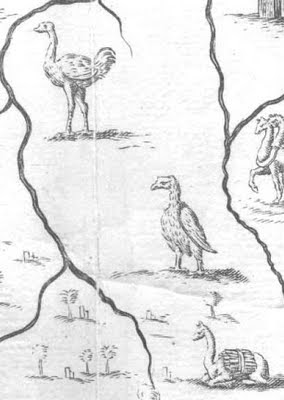Today, as promised, a new post, on the mysterious awurwurs, the ostrich men.
Ostrich Skeleton, the "knee" is actually the "ankle".
Mateo Martinic in his book on the Aonikenk natives of Southern Patagonia [1] wrote about the awurwur as follows (bold mine):
The Patagonian hunters' mythology transmitted by tradition and compiled by some informants and modern & contemporary austors, mentions a "semi-legendary aboriginal group", as Escalada defined it, known under different names such as agongures, agougures, awurwur, aawurwur or auwurwan, aire or airre. They ,according to a legendary aboriginal belief (accepted by authors such as Francisco P. Moreno and Thomas Hrrington), a "Fuegian" group (occidental boat men or kawéskar) settled on the mainland of oriental Patagonia in the southern sector comprising the regions of Santa Cruz and the Strait of Magellan, whose distinctive features were that its members were very fast, because they had their knees facing backwards, like those of ostriches, and they used a tail of feathers
This is very interesting indeed, however I must point out, as you can see in the image above, the things that point backwards are not the bird's knees, they are its ankles!.
The question of the awurwurs is treated by Martinic in a very scholarly manner, and he, of course sets the bird-men aside and goes on to analyze the fuegian boat men.
However, in this blog we can afford to be a bit more extremist, and propose outlandish ideas such as the following:
Could the awurwur myth go back to the days of terror-birds? Do they embody fearful monstrous man eating predators? After all, a ñandú or South American ostrich is a very harmless creature that hides from sight camouflaged by its brown speckled feathers, which blend it into the steppe's vegetation, and its tail is not all that memorable. But what about a gigantic terror bird? (see my posts on them:
Terror birds and some images).
Could this hint at a relatively recent extinction of these giant carnivore birds?
Ok, enough for today! but it is an interesting thought isn't it?
Sources
[1] Martinic, Mateo, (1995). Los Aonikenk, Historia y Cultura. Ediciones Universidad de Magallanes. pp. 93
Patagonian Monsters - Cryptozoology, Myths & legends in Patagonia2011 International Year of Forests Copyright 2009-2011 by Austin Whittall ©























